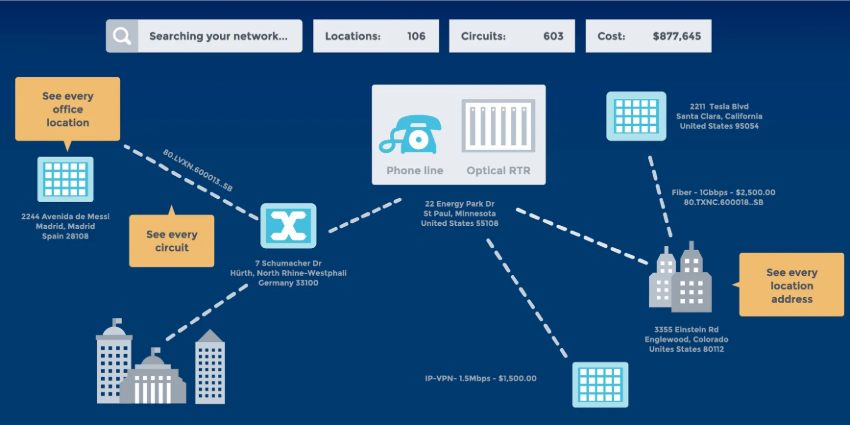We’re living in a new era of communication.
The age of fax and telephone calls has been superseded and enhanced by an incredible digital environment, complete with access to everything from smart voice technology to video. That means that “unified communications,” the art of combining all of your communication strategies, has transformed too.
By 2025, the UC market will hit a value of 167.1 billion. This increase in value comes from a growing prominence in the cloud, changing workforce dynamics, and the virtualization of devices and data. Here’s everything you need to know about the UC landscape of today and tomorrow.
Unified Communications: The News
Unified Communications is a concept that’s constantly changing and evolving.
Originally, most people saw UC as a convenient solution for bringing fax, calls, and email together on a single platform. Now, unified communications can refer to vast stacks of technology, featuring everything from instant chat and collaboration services to video.
Every year, new vendors and opportunities emerge in the marketplace, changing the way that we think about our day-to-day connections. At UC Today, we try to keep you one step ahead of the curve with trending insights and news roundups.
If you’re interested in finding out what’s going on in the UC space, you can check out our latest news and stories. If you want to learn more about what UC is, and where it’s going, read on.
What is Unified Communications?
Unified Communications, or “UC”, is one of the best-known concepts in the modern communications environment. Gartner tells us that it’s the platform or tools that allow companies to access multiple methods of enterprise communication at the same time.
Crucially, UC doesn’t always refer to UCaaS, which is the act of buying unified communication technology delivered “as a service” over the cloud. You can also have on-premise components for your UC environment.
Though there’s no one-size-fits-all version of UC that works for every business, it’s worth noting that the landscape is constantly changing and growing. Today’s UC platforms can include various tools, such as:
- Web conferencing and video
- Real-time messaging for collaboration
- Broadcasting and webinars
- Voicemail and call recording
- Voice PBX
- Contact centre technology
- Audio conferencing
- File and screen sharing
- Presence and schedule management
- Quality monitoring and workforce monitoring
Unified Communication Trends 2020
UC is one of the fastest-growing areas in the communication market. As the landscape grows increasingly complex, businesses are searching for a way to connect all of their tools in a single pane of glass. That means that UC vendors need to be able something scalable, extensible, and endlessly flexible.
While it’s impossible to know for sure what the future of communications might bring, we have noticed several key trends that are standing out in the marketplace, such as:
- Hybrid communications: Thanks to a constant flood of new technology and opportunities from leading vendors, there’s a good chance that the future of UC will become increasingly cloud-based. While not every company will be able to shift immediately to UCaaS, most will begin to implement certain aspects of their communication strategy into the cloud, taking a more hybrid approach to their operations.
- Integration is key: In these flexible and ever-evolving communication stacks, businesses will no longer want to be locked into tools from a specific vendor. Companies are increasingly searching for ways to combine their existing tools and services with new solutions. This could mean that UC environments become increasingly extensible with things like CPaaS, APIs, and new technology.
- New platforms continue to emerge: The communication space is becoming increasingly omnichannel. Various businesses are now embracing a more video-first culture, allowing for deeper face-to-face interactions in the age of remote work. Going forward, it’s likely that we’ll see more platforms emerging in the UC space, from video to voice assistant and instant chat.
- AI is everywhere: Artificial intelligence is changing the way that we communicate on a fundamental scale. We’re living in a world where it’s easy to access crucial data and insights just by tapping into the right platform. Going forward, it’s safe to say that we’ll see more artificial intelligence in our communications, coming from data analytics, smart assistants, and more.
- Team collaboration becomes the new hub for work: In the age of remote work and distributed teams, email is no longer the most efficient way to communicate. We all need access to something more immersive and engaging. Because of this, concepts like UC&C have emerged. These tools combine not just communication services but internal collaboration strategies too.
On top of all these incredible trends, there are also new opportunities appearing on the horizon all of the time. 5G and better connectivity have opened the door to a more mobile workforce, empowered by things like latency-free connections. There’s even potential for AR and VR, delivering mixed realities in the workforce.
Elsewhere, in the reseller environment, trends are aggressively pushing towards new go-to-market strategies, forcing teams to think about new competitors like technology brands in the communication industry. There’s also the concept of the master agent to consider, and a question for resellers and partners to answer on where they’re going to focus next.
Unified Communications 101
For small businesses and large enterprises alike, a unified communication strategy is critical to successful growth. Businesses everywhere need a flexible and reliable environment where they can combine all of their communication needs into one accessible space.
Unified communications helps to streamline and enhance the workforce, encouraging better performance and productivity levels. Some studies indicate that employees using a UC solution can save up to 191 hours of company-wide productivity each day.
UC also unlocks a host of other benefits, such as:
- Reduced costs: When you can combine everything you need for communication and collaboration on the same platform, there’s less need for extra bills and maintenance fees. You can keep costs low, and even access pay-as-you-go functionality
- Stronger experiences: Unified communication delivers better experiences to both your employees and your customers. Your employees can access the tools and information that they need faster, which means that customer problems are solved quicker.
- Improved mobility: With access to the cloud through a UCaaS solution, businesses can tap into a more mobile and flexible workforce. You can even create hybrid environments that give you some benefits from the cloud, and some advantages of an on-premise solution.
- Better IT support: When all of your communication tools are combined, it’s much easier for your IT team to track everything.
- Endless extensibility: As the UC environment continues to grow and evolve, there will continue to be new opportunities for businesses who are willing to stand on the cutting edge of the industry.
Unified Communication Vendors
There are countless companies ready to support your venture into the UC environment today. As mentioned above, the accessibility of the UC landscape is evolving, opening the door to many new computers. Some technology companies and brands from outside of the traditional communications landscape are even beginning to dip their toes in the water.
As the marketplace continues to update and transform, it’s important to ensure that you’re working with the right vendor for your needs. Here’s our list of some of the top performers.
Unified Communications Events
It’s not just the vendors that are changing in the UC world.
Every day, there are new discoveries to explore, from systems enhanced with artificial intelligence, to state-of-the-art technology, perfect for maintaining conversation quality in any environment.
Although the team at UC Today is here to keep you up to date with the latest changes as they happen, there’s nothing quite like exploring the market in person. The best way to do that is to mark your calendars with some of the latest and greatest events for the industry.
Here’s our list of some of the top Unified Communications Events to visit this year.
Unified Communications Reviews
Even with event demonstrations and exhibitions to give you a behind the scenes look at the latest technology, choosing the right unified communication tools is tough. Sometimes, you need a trusted friend to examine the industry’s best phone systems, UC software, and other critical components for you. That’s why we have plenty of UC reviews right here.
While the points you’ll look at when deciding on a unified communications service will differ according to your individual needs, here are some of the top things we recommend looking at:
- Features: Each UC solution has its own strengths and weaknesses to offer. Rather than searching for the tool with the biggest selection of trending features, start with the right mindset. To ensure that you’re investing in the tools that your employees need most, evaluate your business. Find the gaps in your communication processes and work backwards from what you know your company needs.
- Ease of Use: Even if you take the time to find the UC tools that are perfectly suited to your employees’ needs, there’s no guarantee that they’ll use them. Adoption is a major concern for many UC buyers and business owners. To boost your chances of a successful roll-out, make ease-of-use a must-have for any tool.
- Flexibility and growth: A unified communication strategy can often evolve. The things that you need for your business now might not be the same as the tools you need in the future. With that in mind, search for a UC provider that’d dialled in to digital transformation. Is your vendor going to give you opportunities to expand and grow whenever you need to?
- Integrations: Integrations and interoperability are becoming increasingly essential in the current UC landscape. To make sure that your business can evolve to suit your needs, look for a platform that’s open and extensible. Does your vendor play well with others? Can you choose a company that’s going to offer the integrations that you need with the tools your teams uses every day?
- Customer support: Finally, make sure that you’re choosing a UC solution with the right level of customer support. How is the vendor you’re working with going to help you achieve your goals and accomplish new things?
Unified Communications Comparisons
Your modern UC platform can offer everything from telephony services for video conferencing. As the landscape evolves, the opportunities for modern companies transform too. However, not all unified communications platforms are built the same.
Sometimes, when you’re choosing the right UC solution for your team, you’ll have an idea in mind of what you need. Perhaps you’ll be making a choice between Cisco BroadWorks and a new emerging service like RingCentral Office. When you have two distinct competitors in mind, a head-to-head Unified Communications comparison helps with weighing the pros and cons of each service.
Remember, when conducting your comparison, make sure that you have the following questions in mind:
- Does it also support collaboration? Communication isn’t just about connecting with external clients and shareholders. Your team members need to communicate and collaborate too.
- On Premise, Cloud, or Hybrid? How are you going to roll out your unified communication solution? Are you tapping into new opportunities on the cloud, or do you need to combine existing on-premise solutions with futuristic tools?
- What communication trends are you interested in? Do you need a UC company that can deliver on things like artificial intelligence and 5G mobility? Do you want your employees to have the freedom of BYOD components?
- How does it deliver security and privacy? In an age of GDPR and countless other regulations, how will your UC provider keep you and your customers safe? Are your communications encrypted, what standards does your vendor promise?
- Is it future proof? How long can you rely on this UC solution? Will you need to switch to something new down the line, or can you update and improve as you see fit?
Unified Communications Smart Guide
As the virtual workplace continues to evolve, and communication remains the heart of the workplace, UC is more valuable than ever. All businesses, of all sizes are turning to UC as a way to bring their teams and their strategies together.
Without successful communication, businesses can’t provide excellent solutions or customer services that their clients need. Of course, with so many vendors and solutions to choose from, it can be difficult to make a decision that’s right for your brand.
Need more guidance understanding and embracing UC? Check out the UC Today UC Smart Guide, complete with insights into everything from unified communication and collaboration, cloud technology, UC enterprise components, and so much more.






